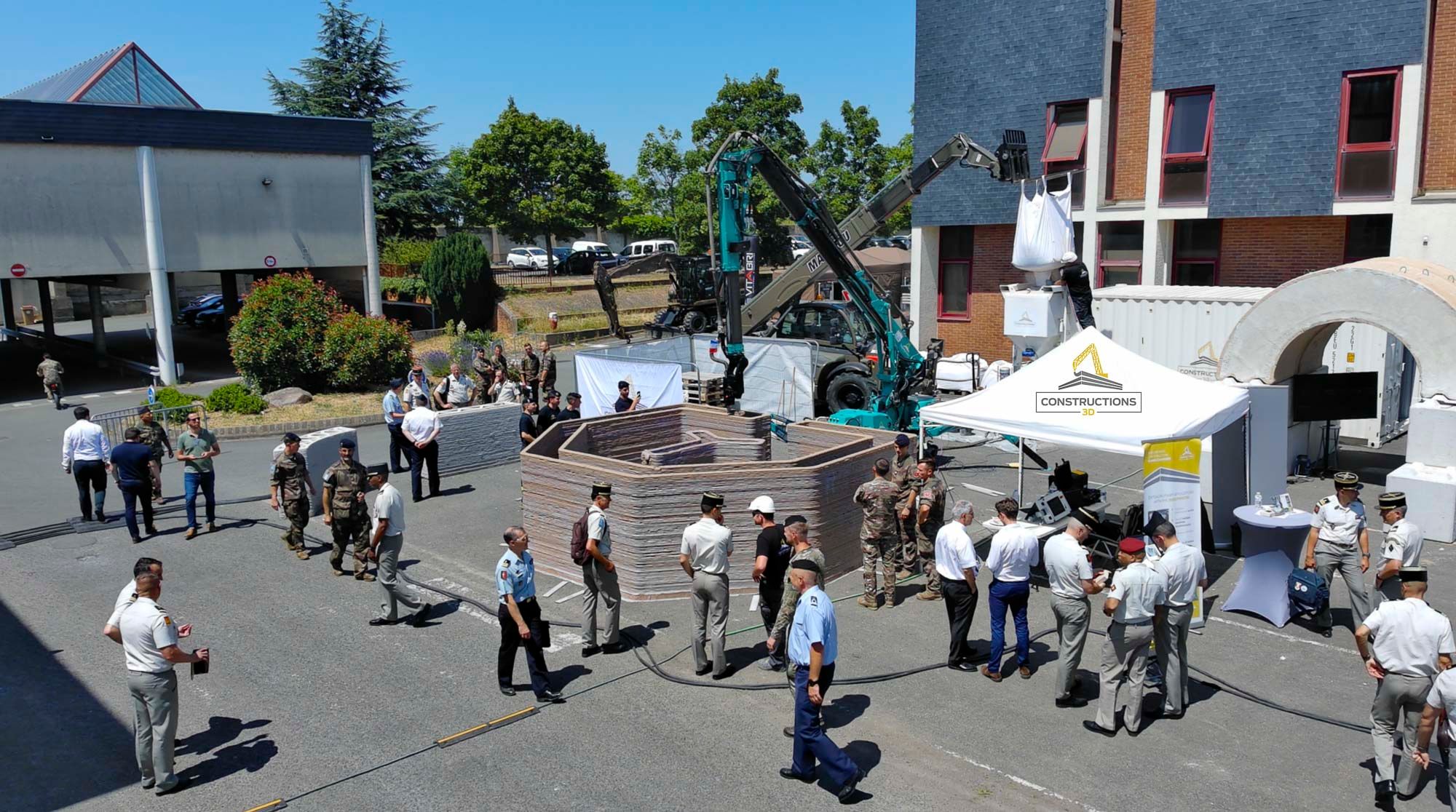The MaxiPrinter Evaluated by the French Army
In a context where the French Army is actively exploring new technologies to strengthen its operational resilience, Constructions-3D was called upon to evaluate 3D printing technology during a Tactical Evaluation (EVTA) conducted by the Army Technical Section (STAT). The objective of this EVTA was to assess the potential of 3D cementitious printing technology in the areas of deployment support, counter-mobility, and force protection. As part of the EVTA, our company also participated in “Dantzig,” the Engineering Corps festival in Angers, where we performed a live 3D concrete printing demonstration of a World War II shelter. “Dantzig” is a special event showcasing current and upcoming innovations in the Engineering Corps. This unique collaboration enabled a rapid skill upgrade for military and structural teams in the field and opened concrete application prospects for the armed forces.
Published on 27 June 2025

Written by Jessica Maciejewski
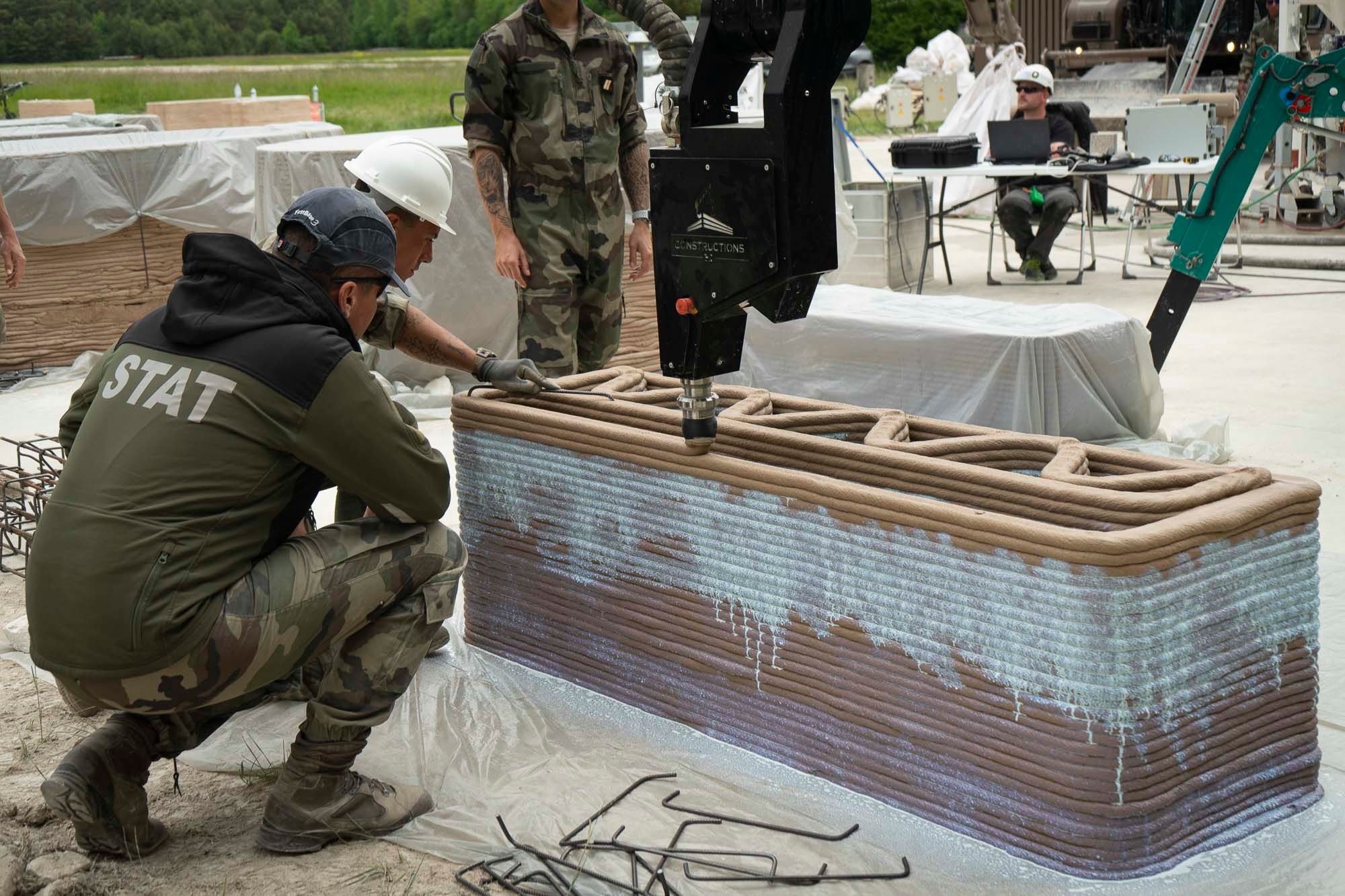
Objective
For Commander Romuald C., a senior officer at the Army Technical Section (STAT), the main objectives of these trials were to:
- Evaluate printing capabilities;
- Assess the benefits and constraints of 3D printing in an operational context;
- Review the implementation and maintenance of such a system.
“The EVTA enabled the printing of around fifteen concrete structures for force protection purposes. Ballistic tests will be conducted this summer to evaluate the 3D printing’s resistance against small-caliber weapons.
The tactical evaluations carried out by STAT, supported by the 19th Engineer Regiment at Mourmelon, went very well. No major technical issues arose that could have significantly hindered the assessments. The equipment and materials provided met the Army’s requirements. The range of printed objects was adjusted according to STAT’s directives.”

This mission, co-developed with the STAT teams, also aimed to test the autonomy of military operators and to gather comprehensive field feedback covering technical, human, and logistical aspects.
According to Lieutenant Colonel Jean D., military infrastructure expert at the Defense Infrastructure Service (SID): “Today, within the scope of our missions, we are required to effectively meet quality standards in infrastructure, notably aligning the performance of our structures with the real needs of the armed forces.
Our current infrastructure considerations focus on protecting our deployed forces and ensuring their long-term resilience.
Protection against mechanical impacts from weapons, threats of physical or cyber intrusion, and requirements for stealth and camouflage.
Resilience primarily addresses optimizing energy, water, and material needs, including waste recovery.
These reflections may eventually lead to the use of innovative construction methods.”

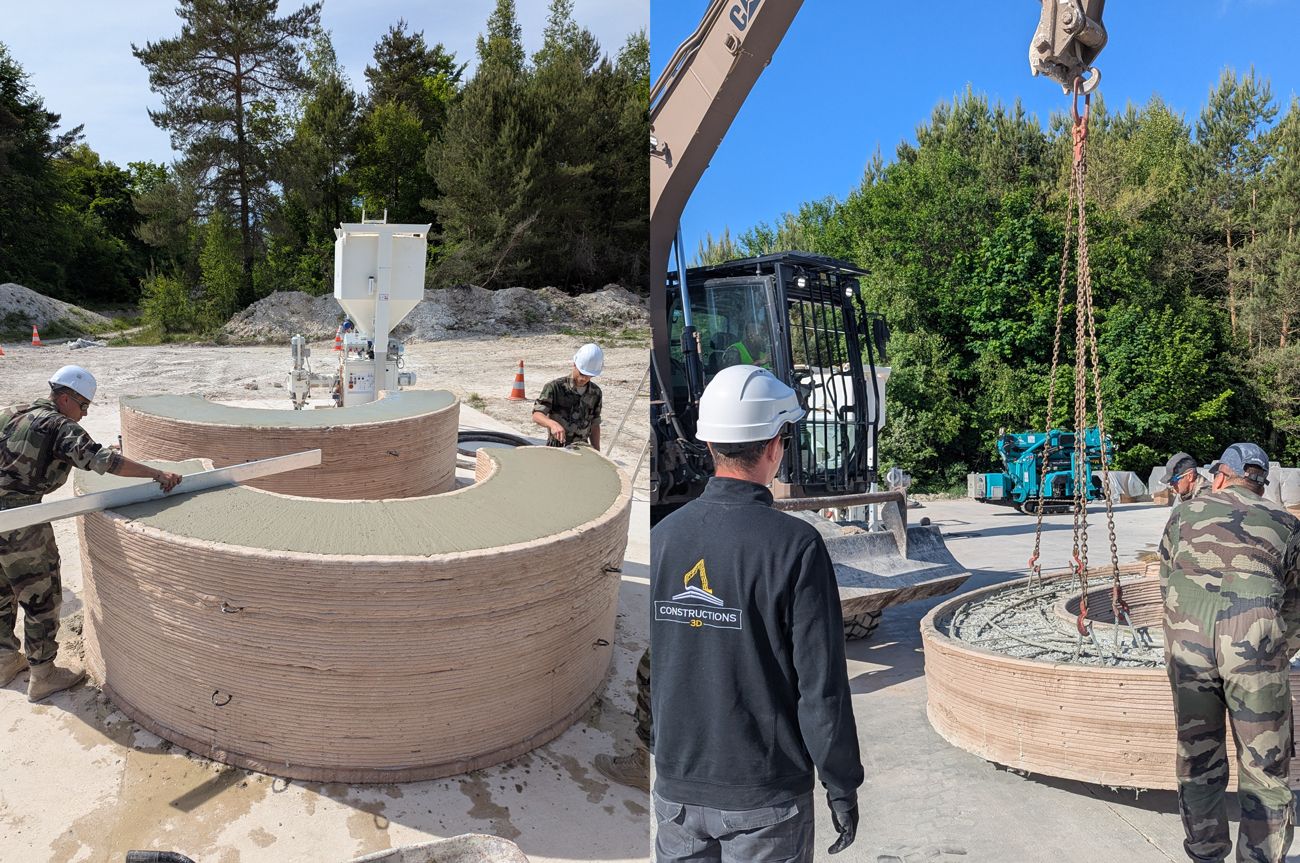
Training and Skill Development: 5 Days, 5 Soldiers, One MaxiPrinter 3D Concrete Printer
The first step was an intensive training for 5 soldiers from the STAT and the 19th Engineer Regiment, supervised by engineers from Constructions-3D. Over 5 consecutive days, the goal was to make the group fully autonomous in deploying, operating, and packing up the MaxiPrinter, Constructions-3D’s large-format 3D concrete printer.
The training covered all key stages needed for independent use of the technology. Participants learned how to deploy and fold the MaxiPrinter, install the pumping and mixing system, and configure the machine autonomously. They were also trained on loading the silo with 3D material, handling big bags, and preparing prints via the AirPrint interface.
Practical exercises familiarized them with reinforcement installation and concrete pouring within printed modules, taking into account specific field constraints. Special attention was given to routine maintenance management and procedures to follow in case of technical issues, ensuring operational continuity on site.
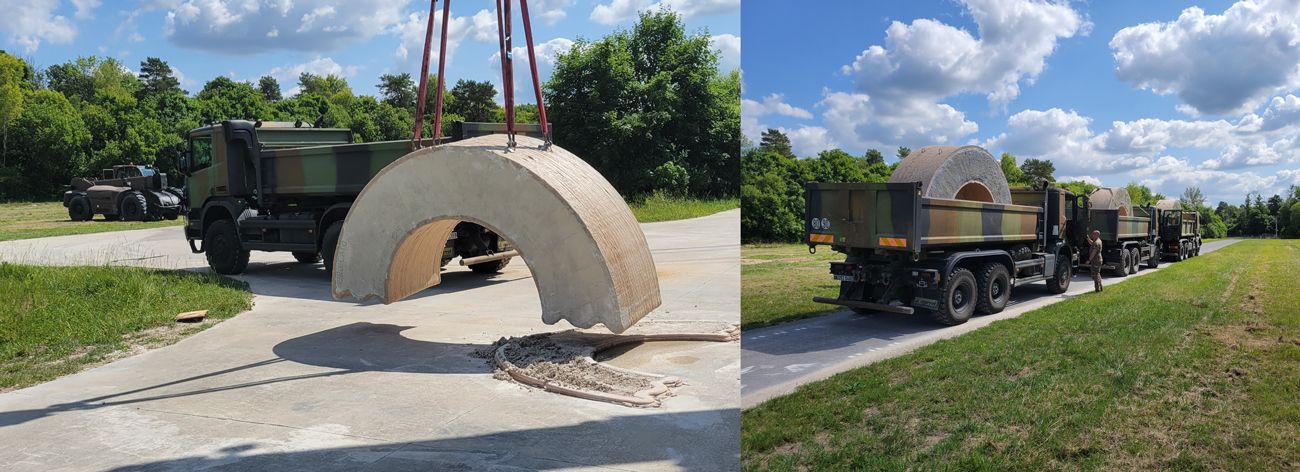
Rapid Skill Development
By the third day, participants reached 95% operational autonomy, according to our trainers Johan Bauduin, Mattis Solé, and Mickaël Deleplanque. The machine’s accessibility, combined with the military’s discipline and precision, enabled rapid skill development and remarkable trainee engagement.
The SID EPN (Defense Infrastructure Service—Expertise and National Production) continued supporting Constructions-3D and the Army to design, model, and adapt objects that meet the forces’ needs and printing constraints.
Technical Achievements: Concrete Demonstrators for Military Applications
Beyond training, this mission had a technical goal: to produce realistic prototypes representing real-use cases. The printed structures were designed to test 3D concrete printing’s ability to meet the specific demands of engineering operations.
Each piece was printed on-site, under real conditions, on initially uneven terrain, using a printed raft to restore flatness. Vaults and tunnels were cast afterward to test their core structural strength.
Several innovations were successfully tested during printing. The direct integration of lifting hooks into the print layers facilitated handling without the need for drilling or post-print additions. The teams also experimented with mixed reinforcement, combining pre-integrated elements during printing and manually inserted rebar, striking a good balance between strength and speed.
High-flow casting of several cubic meters of concrete per vault was achieved without causing collapse or deformation of the modules. Finally, post-print strength tests confirmed the durability of the structures: the vault held perfectly, demonstrating the immediate viability of the printed parts under real-world conditions.
The vault offers notable ballistic advantages but remains a complex structure to build traditionally. SID EPN will continue optimizing material design and structural span.
Field Feedback: Strengths and Areas for Improvement
This training demonstrated a quick learning curve, accessible even to operators without prior specialization, along with robustness and simplicity—a rugged design suited to field constraints and requiring minimal maintenance.
The MaxiPrinter’s flexible use adapts to various operational scenarios, including passive defense, shelter construction, custom or adaptable elements, and bridging modules.
Operators also provided several improvement suggestions linked to their specific needs and field conditions, aimed at optimizing the machine’s future use in operational environments.
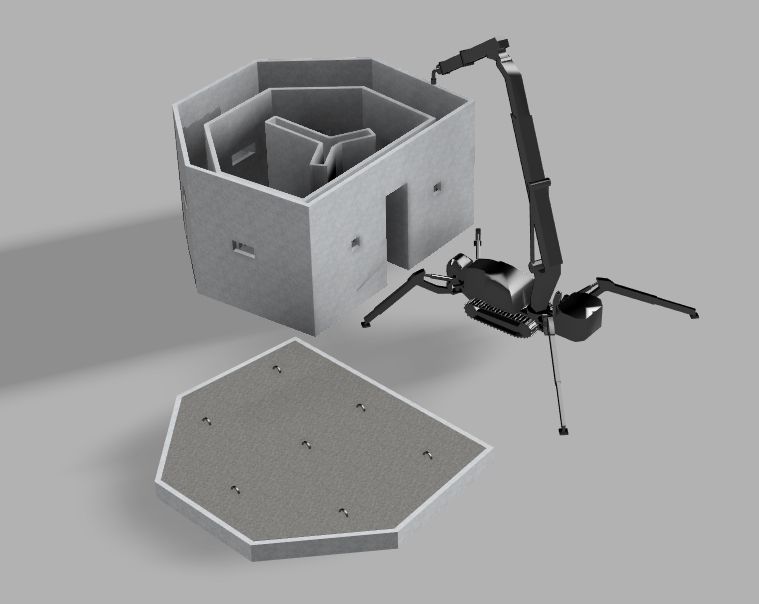
Heading to Dantzig
Following this evaluation mission, we participated in the Engineering Festival in Angers to showcase the MaxiPrinter’s capabilities live to a larger but equally knowledgeable audience. Throughout the day, our team continuously printed a replica of a World War II shelter directly at our booth, using a custom material developed by Termix-3D.
Constructions-3D’s President, Antoine Motte, spoke as a keynote witness, sharing his entrepreneurial vision for innovation in additive construction.
We warmly thank the Engineering School for inviting us to “Dantzig.” This event provided excellent visibility among military engineering decision-makers and created a great environment for constructive exchanges and valuable networking.
